



Cost-benefit analysis II MPA 612: Public Management Economics March 28, 2018 F i l l o u t y o u r r e a d i n g r e p o r t o n L e a r n i n g S u i t e !
Plan for today How do we judge projects? Why is CBA controversial? Lots of CBA practice
Current events
How do we judge projects?
Important CBA numbers Benefit cost ratio (BCR): Total benefits / Total cost Internal rate of return (IRR): Breakeven discount rate Net present value (NPV): Benefits − costs
Standards of fairness/efficiency Pareto standard Nobody made better off without someone being made worse off Kaldor-Hicks standard Potential Pareto Adopt policy iff those who gain could compensate those who lose and still be better off
Social surplus and economic pie
Social surplus and economic pie
Social surplus and economic pie
Social surplus and economic pie
Should we do projects or policies where NPV < 0? Sometimes, yeah, if we’re comfortable with DWL or outcome Sin taxes; Pigovian taxes; subsidies Justify the policy on other grounds
Why is CBA controversial?
Incommensurability Discounting Distribution
Incommensurability Critics say you can’t monetize everything How do you measure the benefits of cheaper electricity against the loss of a pristine view of the Grand Canyon? Critics say life is priceless
Incommensurability But life is full of scarcity and tradeoffs What if new program only hurt our view of the Grand Canyon for one 15-second interval every 10 years? “Claiming that different values are incommensurable simply hinders clear thinking about difficult tradeoffs” Robert Frank, “Why is Cost-Benefit Analysis So Controlversial?,” Journal of Legal Studies 29 (2000)
Discounting Critics say CBA doesn’t discount future utility We don’t know how much people in the future will appreciate the projects Sure. So guess and include future generations. And do lots of sensitivity analysis
Distribution This critique is trickier Kaldor-Hicks doesn’t require that compensation actually happen Benefits depend on WTP, which can be irrational and can favor the rich
Distribution If NPV > 0, total social surplus (economic pie) grows It could all go to one person though ¯\_( � )_/¯
Distribution Issues with contingent evaluation People think they can influence policy People hyperbolically discount People can’t think in hypotheticals People are loss averse
By attending class today, you have been exposed to a rare, fatal disease. The probability that you have the disease is one in a thousand. If you have the disease you will die a quick and painless death in one week. There is a cure for the disease that always works, but it has to be taken now. We do not know how much it will cost. You must say now the most you would be willing to pay for this cure. If the cure ends up costing more you won’t get it. If it costs less, you will pay the stated price, not the maximum you stated. How much will you pay? We are conducting experiments on the same disease ↑ $800 for which we need subjects. A subject will just have to expose him or herself to the disease and risk a one-in- a-thousand chance of death. What is the minimum fee ← $10,000 you would accept to become such a subject?
Distribution Issues with revealed preferences VSL based on idea that high risk jobs pay more
Distribution Issues with revealed preferences VSL based on idea that high risk jobs pay more VSL based on idea that people self-sort into high risk jobs
VSL = $50,000
Lots of CBA practice Sensitivity analysis!
A country is considering installing a water treatment system in a rural community that is expected to cause environmental and direct benefits of $1,000,000 per year for its inhabitants. The system would require an investment of $9,000,000 and have operating and maintenance costs of $300,000 per year for an expected life of 20 years, after which it would have no value. If money for this type of project costs the country 6% (i.e. the discount rate is 6%), is the project justified? If USAID is willing to pay $4,000,000 of the investment, is the project justified?
Recommend
More recommend